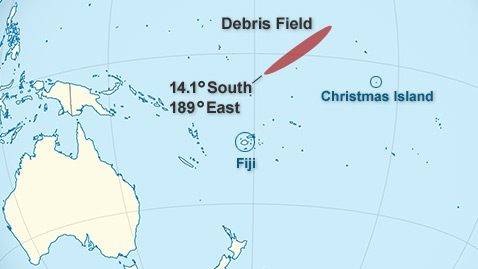NASA UARS Satellite Crash Site: Near Christmas Island in Pacific

Artist's conception of UARS satellite in orbit. Source: NASA
NASA now says the final resting place of its UARS satellite is a remote part of the South Pacific, halfway between Australia and Hawaii, perhaps closest to what used to be called Christmas Island in the island nation of Kiribati. The satellite fell to Earth just after midnight, EDT on Saturday morning, after days in which scientists speculated — and engaged in some gallows humor — over where it would come down.
In an update, based on information from the Air Force Joint Space Operations Center at Vandenberg Air Force Base in California, NASA said, “The satellite entered the atmosphere over the Pacific Ocean at 14.1 degrees south latitude and 189.8 degrees east longitude. This location is over a broad, remote ocean area in the Southern Hemisphere, far from any major land mass. The debris field is located between 300 miles and 800 miles downrange, or generally northeast of the re-entry point. NASA is not aware of any possible debris sightings from this geographic area.”

Map shows where UARS satellite came down. Oval is area where debris may have landed. ABC News
UARS’s debris, if anything in fact reached Earth’s surface, is far from land … but also far from the area off the Pacific Northwest where NASA said on Saturday it thought the satellite could have come down. For all the precision involved in launching a spacecraft and tracking it in orbit, tracking its demise is still inexact. NASA said the upper layers of the atmosphere are highly variable, which is why it was so hard to say just where UARS was slowed enough that it could no longer maintain orbital speeds.
NASA had said well in advance that the odds were in 1 in 3,200 that anyone on Earth would get dinged by the thing.
By the way, don’t look now, but there’s another satellite descending into the upper atmosphere now, expected to de-orbit sometime on October. It’s called ROSAT — a German X-ray observatory launched by the U.S. in 1990. Because it carried heavily-shielded observing equipment, the German aerospace lab DLR says there’s a 1-in-2,000 chance that it will hit someone.
Is there a sudden storm of satellites raining to Earth? NASA says no, there are pieces of junk burning up in the atmosphere just about daily. UARS was just large enough to provoke a teleconference and get people’s attention. If we hear of any debris spotted in Fiji or the Solomon Islands, we’ll let you know.